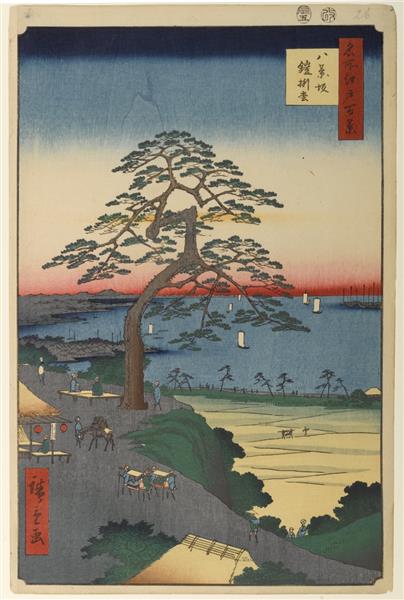Descrizione
In “The Hanging Pine Tree at Hakkeizaka Bluff,” Utagawa Hiroshige presents a work that encapsulates the essence of Japan’s nature and culture during the Edo period. Painted in 1857, this work is part of the “Fifty-three Stations of the Tōkaidō” series, which documents the famous road that connected Kyoto and Edo (present-day Tokyo), where travelers reveled in the scenic beauty of their surroundings. In this print, the focus is on an iconic tree, a pine tree that stands not only as a natural element, but as a point of connection between man and his history.
The composition of the work is masterful, using the diagonal of the pine tree to guide the viewer’s gaze from the foreground to the background, where a mountainous landscape of gentle hills extends. This play of lines and shapes creates a sense of depth, a distinctive feature of Hiroshige’s work, which always seeks to involve the viewer in the visual experience of the environment. The pine tree, hanging with armour strapped to its branches, suggests a tale of samurai valor, alluding to Japan’s military history, while the serenity of the landscape conveys a sense of peace and contemplation.
Hiroshige employs a color palette that serves to accentuate both the richness of the landscape and the simplicity of the pine tree. The deep greens of the trees contrast with the softer tones of the sky and hills. The interplay of light and dark not only highlights the form of the pine tree, but also emphasizes its symbolism as a guardian of history and tradition. These colors combine in a harmonious balance, a skill that the artist mastered to perfection.
There are no human figures to distract from the central message, further emphasizing the dialogue between nature and memory. However, the implicit presence of the traveler, who would surely be among the audience observing the hanging armor, reinforces the narrative of the cultural intersection between man and his environment. This approach of leaving individuals out of the frame invites the viewer to identify with the journey and the contemplation of the landscape.
The work is also a testament to the ukiyo-e style, of which Hiroshige is one of the most renowned exponents. This style is characterized by its focus on themes of everyday life, nature and landscape, elevating the ephemeral to a level of contemplation and reverence. “The Hanging Pine Tree at Hakkeizaka Bluff” is not just a depiction of a moment in time, but stands in an ongoing dialogue with past and present traditions, exploring the relationship between the human and the natural.
In conclusion, this painting by Hiroshige is a masterpiece that not only captures the immediate beauty of the Japanese landscape, but also invites reflection on culture, history and memory. The interconnection of its visual and narrative elements traces an emotional map that takes the viewer on an introspective journey through time, a lasting testament to the art of ukiyo-e and the unparalleled skill of its creator.
KUADROS ©, a famous painting on your wall.
Hand-made oil painting reproductions, with the quality of professional artists and the distinctive seal of KUADROS ©.
Painting reproduction service with satisfaction guarantee. If you are not completely satisfied with the replica of your painting, we will refund 100% of your money.

